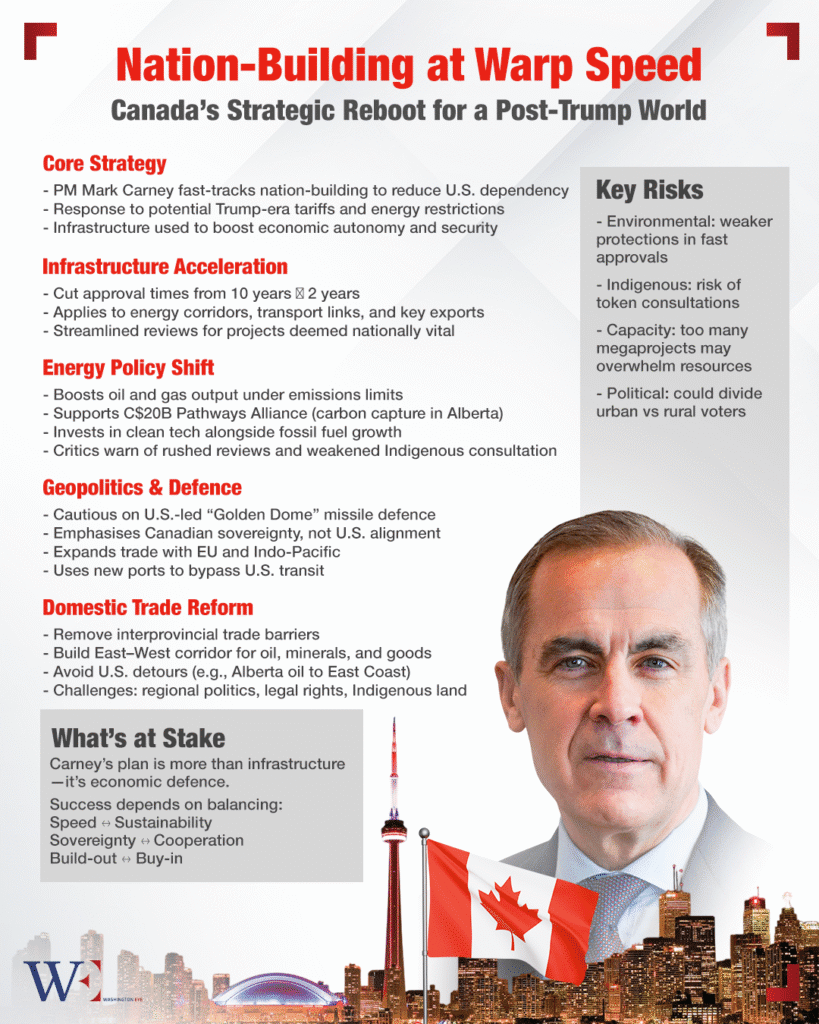In a major policy pivot aimed at redefining Canada’s economic sovereignty, Prime Minister Mark Carney has announced a sweeping plan to fast-track nation-building projects. This initiative is intended not merely to stimulate the domestic economy but to serve as a bulwark against renewed protectionist threats from the United States under Donald Trump. As cross-border uncertainty looms, Ottawa is preparing for a future where Canadian prosperity may require more autonomy from its largest trading partner.
Expediting Projects: Strategic Autonomy in Action
Carney’s administration is targeting a dramatic reduction in approval times for large-scale infrastructure—from up to a decade to just two years. This accelerated timeline applies to projects deemed to be in the national interest, including energy corridors and transportation infrastructure, which are now prioritized for streamlined regulatory and environmental reviews.
This shift is not simply about efficiency. It’s about strategic autonomy. With Trump’s return threatening renewed tariffs and “America First” energy policies, Ottawa is preemptively reengineering its internal economic arteries to reduce dependency on U.S. imports, exports, and regulatory alignment. Infrastructure, in this context, becomes an instrument of sovereignty.
Energy Policy Realignment and Environmental Trade-offs
Perhaps the most striking realignment is in energy policy. Once a staunch advocate of stringent climate policy and carbon pricing, Carney is now engaging with the oil and gas sector to increase production and exports—albeit under conditional emissions frameworks. Central to this shift is support for Alberta’s C$20 billion Pathways Alliance carbon capture initiative, which aims to balance oil expansion with decarbonization.
This dual-track approach—stimulating fossil fuel output while investing in clean tech—reflects a pragmatic strategy. Yet, it brings with it inherent contradictions. Environmental groups and many Indigenous leaders warn that speeding up approvals may water down environmental assessments and compromise consent-based consultations. The government’s promise of “meaningful” Indigenous engagement will be tested as timelines tighten.
Geopolitical Realignment: Security Without Subordination
On the geopolitical front, Canada is cautiously navigating deeper defense integration with the U.S. without compromising national sovereignty. Trump’s proposal to include Canada in a North American missile defense “Golden Dome” system—a project aimed at shielding the continent from external threats—was met with qualified interest in Ottawa. Carney made it clear that Canada would not accept such integration “on U.S. terms” or “as a 51st state”.
Canada’s broader strategy includes diversifying trade relationships beyond the U.S., particularly by enhancing ties with the EU and Indo-Pacific economies. Infrastructure acceleration feeds directly into this ambition by enabling the export of energy and critical minerals via Atlantic and Pacific ports, rather than depending on U.S. transit.
Internal Trade and Infrastructure Federalism
Another pillar of the strategy is the dismantling of interprovincial trade barriers and the construction of an east-west trade and energy corridor. The goal is to enable a seamless domestic market that reduces logistical and regulatory fragmentation—long seen as a hidden tax on Canadian productivity. This would allow, for example, Alberta oil to reach Eastern refineries without detouring through the U.S.
However, achieving this requires unprecedented federal-provincial coordination. Legal hurdles, regional politics, and Indigenous land rights could complicate implementation, especially if projects are perceived as being federally imposed rather than co-developed.
Implications: A Nation Rebuilt or Overextended?
The implications of Canada’s accelerated infrastructure agenda are both expansive and consequential. First, in terms of sovereignty and resilience, the plan signals a fundamental shift in Canada’s post-NAFTA identity. By aiming to shield itself from potential Trump-era trade shocks, the government is elevating infrastructure from a domestic development concern to a tool of foreign and trade policy.
On the environmental front, compressing the approval process raises concerns about regulatory dilution, especially in ecologically sensitive regions. The tension between climate commitments and expanded fossil fuel infrastructure risks undermining Canada’s international reputation as a climate leader.
When it comes to indigenous rights, the rapid project timelines could lead to superficial or rushed consultations. This not only strains relationships with First Nations but may also expose the government to legal challenges and civic resistance, particularly if projects are seen as federally imposed rather than co-designed.
There are also executional risks. Attempting to launch and complete multiple megaprojects within such condensed timelines could overwhelm federal and provincial capacities. Limited availability of skilled labor and engineering talent may cause delays, budget inflation, or compromised build quality. Whether Canada’s institutions can manage this scale of implementation without eroding transparency and accountability remains uncertain.
Finally, the political implications are nuanced. While the plan is likely to resonate with voters seeking economic security and national self-sufficiency, it may also deepen Canada’s urban-rural divide. Regions that prioritize environmental protection may view this industrial push as a step backward, complicating Carney’s coalition-building efforts ahead of future elections.
A Final Note
Carney’s expedited infrastructure strategy is not merely about concrete and steel—it is a calculated response to geopolitical instability, economic concentration, and a volatile neighbor to the south. Whether this amounts to genuine nation-building or an overextended bet on industrial nationalism will depend on how well Canada can balance speed with sustainability, inclusion with execution, and sovereignty with global interdependence.














